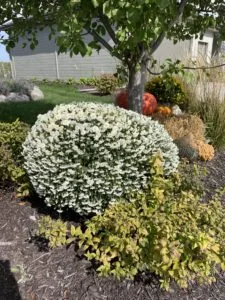While you may traditionally think of spring as the best time to plant, the truth is that professional landscapers widely regard fall as the ideal planting season. In Part 1 of our comprehensive fall planting guide, Stu Buerman, Jake Steiner, and Jake Wolfe explain why fall weather is plant-perfect and what to plant for optimal results.
Why Fall?

There are multiple environmental conditions that make fall the most advantageous planting season, and they all lead back to establishing strong roots. Plants have a stronger chance of survival if they have adequate time to establish roots outside of their original planting zone.
During fall, the ground and air temperatures are just right. Soil is still warm enough for new plants to readily root in before winter. And, in the evenings, temperatures drop enough to give new plants respite from the heat, which means no aggressive watering schedule is needed.
Once the plants root in and the cold comes, they will set dormant until spring when they’re ready to explode in growth. The result? Plants that bloom and flourish as the weather warms up.
Keep in mind that there is a recommended stopping point for fall landscaping. Though the ground still carries some warmth, it is advisable not to plant perennials past the second week of October.
What to Plant
You can plant just about any type of flower, tree, or shrub in fall with minimal exceptions:
- Perennials and Grasses: Planting these in early fall provides adequate time to establish a root system, giving them a head start for spring.
- Cool Season Annuals: Pansies, violas, ornamental kale, and mums are some of our fall favorites. They provide a fresh burst of color and can last until the soil freezes. Some may even produce color after a light snow.
- Bulbs: If you enjoy the early spring pop of color that tulips provide, plant your bulbs in late fall. You should wait until soil temps are low, but not frozen.
- Shrubs: Most shrubs are fine to plant up until the ground freezes. Be careful with roses, hydrangea, rhododendron, arborvitae, and box woods, as they tend to be more susceptible to drying out, wind burn, and winter dieback than some of the woody plants that grow in our climate.
- Trees: Most shade and ornamental trees can be planted until the ground freezes, although birch trees, Japanese maples, and evergreens can be at risk of winter kill if they don’t have adequate time to establish a root system.
Fall is also an excellent time to transplant your landscaping. The key is to NOT transplant anything mid-bloom; wait until a few weeks after until your plants are done blooming to make a move. Also, be sure to finish your transplants before a hard freeze – typically by the end of October.
Watering Fall Plants
Proper watering technique is vital to ensuring your fall plants thrive come springtime. All new plants should be watered thoroughly to backfill any air pockets. The soil near the plant should stay moist – not wet or soaked — for the first two or three weeks after planting.
Watering deeply and thoroughly every few days is preferential to shallow or overly frequent watering. Deep watering allows the roots to chase the moisture farther into the soil, promoting a more vigorous root system. Shallow watering, or watering too frequently, can create a narrow region in the up-layer of soil that plants will hesitate to root past.
When in doubt, do a touch-test. If the soil is wet or damp to the touch, the plant probably doesn’t need water. Only water if the soil feels dry or barely damp. And, be sure you’re checking the soil for moisture, not just the mulch surrounding the plant.
In Part 2 of this series, we will talk about which plants should be cut back, proper pruning techniques, and prepping all areas of your landscaping for a long winter’s nap and, subsequently, a beautiful spring!
Clear Creek Landscaping is an Omaha landscaping company comprised of experienced landscape design professionals. Whether you’re looking for backyard design in Omaha, an Omaha patio builder, an Omaha paver patio designer, or custom landscape design in Omaha, the team at Clear Creek Landscaping has the experience and knowledge to handle it all.


Comments (0)
Thanks for your comment!
Thanks for your feedback! Your comments have been successfully submitted! Please note, all comments require admin approval prior to display.
Error submitting comment!
There is a problem with your comment, please see below and try again.